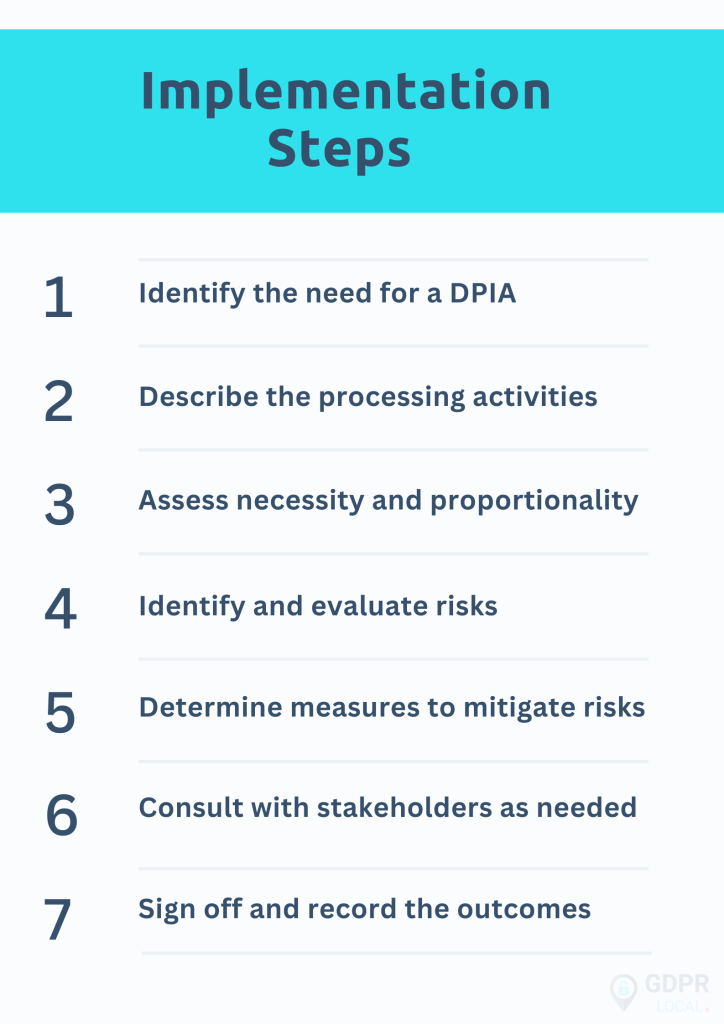
The Data Protection Impact Assessment: Evaluating Privacy Risks
Keeping personal data safe has never been more essential than in the today’s digital era. The Data Protection Impact Assessment (DPIA) emerges as a tool for organizations aiming to prevent privacy breaches. This forward-thinking approach not only assists in identifying potential privacy risks but also plays a crucial role in the development and implementation of projects or systems involving personal data.
This article will explain when DPIAs are necessary, how they are conducted, and the common challenges faced during the process. Understanding the DPIA process enables effective evaluation of privacy risks in data processing. When organizations are familiar with conducting a DPIA, then they can proactively address and mitigate potential privacy impacts, reinforcing their data governance frameworks.
Understanding Data Protection Impact Assessments (DPIA)
A Data Protection Impact Assessment (DPIA) is a systematic process aimed at identifying and minimizing the data protection risks associated with a project or plan. It demonstrates compliance with data protection obligations under regulations like the UK GDPR.
Key Aspects of DPIAs
Legal Requirements and Fines
Conducting a DPIA is not just a best practice but a legal necessity for certain types of data processing that pose a high risk to individual rights and freedoms. Failure to conduct a DPIA when required can lead to enforcement actions, including fines up to £8.7 million or 2% of global annual turnover, whichever is higher.
Proactive Risk Management
DPIAs facilitate proactive identification and mitigation of risks before processing begins. This aligns with the GDPR’s mandate for ‘data protection by design and default,’ ensuring that data protection measures are embedded from the outset of any project.
Financial and Reputational Benefits
Beyond compliance, effective DPIAs can lead to significant financial and reputational benefits for organizations. Early identification of potential issues typically results in simpler, less costly solutions and helps avoid potential reputational damage that could arise from privacy breaches.
Scope and Scalability
A DPIA can address a single processing operation or a set of similar operations. It can be scaled according to the nature of the project, ensuring that the time and resources invested are appropriate to the level of risk.
Ongoing Process
It is essential to view DPIAs as ongoing processes rather than one-off exercises. They should be regularly reviewed and updated to reflect any changes in the project or its environment, ensuring continuous management of risks.
Implementation Steps
A DPIA should commence early in the project lifecycle and include several key steps:

Consultation and Documentation
Consultation with stakeholders, including potentially affected individuals, is a crucial part of the DPIA process. If an organization has a Data Protection Officer (DPO), their advice should be sought and documented. The process relies on the DPO’s feedback regarding the necessity of a DPIA, how to conduct it, and the adequacy of proposed measures.
Regulatory Guidance and Compliance
Under the GDPR, DPIAs are mandatory for new projects that involve high-risk processing activities. The regulation outlines specific scenarios and processing activities that typically require a DPIA, such as large-scale processing of sensitive data or systematic monitoring of public areas.
In summary, DPIAs are vital tools for organizations to manage data protection risks effectively. They support compliance with legal requirements and enhance the organization’s ability to protect the interests of individuals, thereby fostering trust and transparency.
When to Conduct a DPIA
Organizations must conduct a Data Protection Impact Assessment (DPIA) when processing activities are likely to result in high risks to the rights and freedoms of individuals. This requirement is particularly critical when introducing new data processing systems, technologies, or processes that could significantly impact data privacy.
Legal Requirements
Under the General Data Protection Regulation (GDPR), conducting a DPIA is mandatory for certain types of data processing activities that pose a high risk to individual rights and freedoms. Such activities include systematic and extensive profiling that affects individuals significantly, large-scale processing of special category data, or systematic monitoring of publicly accessible areas. Failure to perform a DPIA under these circumstances can lead to substantial penalties, including fines up to 2% of the annual global turnover or €10 million, whichever is greater.
The GDPR requires a DPIA for scenarios involving new technologies or large-scale processing of sensitive personal data. Additionally, any form of systematic monitoring or profiling that could have legal or similarly significant effects on individuals also requires a DPIA.
Best Practices
To align with best practices, organizations should initiate the DPIA at the early stages of any project involving personal data. Privacy by design embeds privacy and data protection considerations from the outset. Conducting a DPIA early helps identify potential privacy issues when they are easier and less costly to address, thereby enhancing overall data protection awareness within the organization.
Besides legal compliance, regular DPIAs support the GDPR’s accountability principle, helping organizations demonstrate their commitment to data protection. This proactive measure not only safeguards against privacy risks but also builds trust by demonstrating commitment to protecting individual rights.
In summary, determining when to conduct a DPIA involves understanding both the nature of the data processing activities and the potential risks they pose to individuals.
Steps to Perform a DPIA
Identify the Need
The initial step in a Data Protection Impact Assessment (DPIA) is to identify whether such an assessment is necessary. This determination typically stems from the nature of the data processing activities involved, especially when they are likely to pose a high risk to individuals’ rights and freedoms. For instance, if a service processes children’s personal data, a DPIA becomes imperative as per Standard 2 of the Children’s Code, which mandates assessments to mitigate risks to children.
Describe the Information Flow
Describing the flow of information is critical. Organizations must detail how personal data is collected, stored, used, and eventually deleted. This description should encompass the types of data processed, the data’s sensitivity, and who will have access to it. It’s crucial to outline the nature, scope, context, and purposes of the processing accurately to anticipate potential privacy issues and regulatory compliance needs.
Evaluate Risk Levels
Evaluating the risks associated with data processing involves a thorough analysis of potential impacts on data subjects. Organizations should assess the severity and likelihood of risks, considering factors like data sensitivity and processing scale. This evaluation should identify scenarios where data misuse could lead to adverse outcomes such as identity theft, financial loss, or other forms of harm.
Mitigation Strategies
Once risks are identified, the next step is to devise strategies to mitigate them. This may include minimizing data collection, enhancing data security measures, or implementing strict access controls. Each identified risk must be addressed with appropriate measures to reduce it to an acceptable level. Regularly monitor and review the effectiveness of these strategies to adapt to changes in the processing environment or emerging threats.
Common Challenges in DPIAs
Identifying Risks
One of the primary challenges in conducting a DPIA is the identification of all potential risks to individuals whose data will be processed. These risks can range from data breaches that lead to material or non-material damage, to issues like identity theft, fraud, or even physical harm. Assessments evaluate risks using tools like risk assessment matrices to systematically consider likelihood and severity.
Data Accuracy
Ensuring the accuracy and reliability of personal data is crucial in DPIAs. Organizations must assess the quality of data being processed to prevent any adverse effects on individuals’ rights and freedoms. Inaccurate or outdated data can undermine the integrity of the DPIA process, leading to flawed assessments and potential legal non-compliance.
Stakeholder Involvement
The involvement of stakeholders is another significant challenge in DPIAs. This includes a range of participants from data controllers and processors to citizens and data protection authorities. Each stakeholder group brings a unique perspective that can influence the DPIA process. However, practical challenges such as obtaining a representative view from all stakeholders, especially the public, can complicate the process. To address these challenges, organizations often employ strategies such as transparency and considering the average citizen’s perspective.
Each of these challenges requires careful consideration and strategic planning to ensure that DPIAs are effective and compliant with data protection laws. By addressing these common issues, organizations can enhance the thoroughness and effectiveness of their data protection impact assessments.
Conclusion
evaluating privacy risks and the paramount importance of these assessments in the digital age. DPIAs stand as a mandatory and strategic process under GDPR, aimed at minimizing data protection risks and fostering a culture of privacy by design. Assessments fulfill legal obligations and enhance consumer trust by proactively identifying and mitigating privacy issues.
It is crucial for organizations to embed DPIA processes into their project lifecycles, thus ensuring a steadfast commitment to data protection and privacy.
FAQs
What are Privacy Impact Assessments (PIAs) and Data Protection Impact Assessments (DPIAs)?
A PIA focuses on analyzing how an organization collects, uses, shares, and maintains personally identifiable information, assessing any associated risks. A DPIA, on the other hand, aims to identify and minimize the risks involved in processing personal data.
How do you conduct a Data Protection Impact Assessment (DPIA)?
The DPIA process includes several key steps:
Step 1: Determine the necessity for a DPIA.
Step 2: Describe the data processing activities.
Step 3: Consider the need for consultation.
Step 4: Assess the necessity and proportionality of the processing.
Step 5: Identify and evaluate potential risks.
Step 6: Determine measures to mitigate identified risks.
Step 7: Finalize, sign off, and record the DPIA outcomes.
What is a Data Privacy Risk Assessment?
A Data Privacy Risk Assessment involves evaluating the current state of data security within an organization’s ecosystem. This assessment helps in identifying vulnerabilities and implementing necessary changes to reduce the risk of cyberattacks and other security threats.
What are the three main objectives of a Privacy Impact Assessment (PIA)?
A PIA aims to achieve three primary objectives:
– Ensure compliance with applicable legal, regulatory, and policy requirements concerning privacy.
– Identify and evaluate the risks and effects associated with data processing.
– Explore protective measures and alternative processes to reduce potential privacy risks.